The telecommunications industry is undergoing rapid change as it works to meet growing demand for faster, more reliable, and personalized services. With the rise of new technologies like 5G and IoT, as well as competition from alternative communication channels, telecom companies must modernize their infrastructure and services to stay competitive.
Cloud computing has become a key solution for telecom providers, offering ways to improve efficiency, cut costs, and deliver better customer experiences. However, adopting cloud-based solutions in such a complex industry comes with its own challenges and requires careful planning and the right approach.
In this article, we explore how cloud computing can help telecom companies improve their services. We also list the benefits of cloud computing in the telecom industry and tackle the key cloud implementation and management challenges that businesses should keep in mind.
What is cloud computing in telecommunications?
The telecommunications (or telecom) industry includes cable companies, internet service providers, satellite communications providers, and telephone companies. As modern telecom companies often go beyond providing the traditional set of telecommunications services, they are sometimes also referred to as communications service providers (CSPs). In this article, we’ll use these terms interchangeably.
Cloud computing in telecommunications refers to using cloud-based infrastructure, platforms, and applications to deliver and manage telecom services. By moving parts of their systems to the cloud, telecom companies can store and process data remotely instead of relying on physical data centers.
The Covid-19 pandemic that began in 2020 highlighted the importance of this shift, which is still happening today. At the start of the pandemic, the majority of communications that usually happened in person were suddenly conducted through telecommunications channels. To be able to cope with such a load and expand services on demand, telecom companies have transformed parts of their infrastructure into cloud-based applications. Thus, they can store and process data remotely instead of purchasing and maintaining their own physical data processing centers.
Instead of relying solely on traditional on-premises infrastructure, telecom companies now use cloud computing models like Infrastructure-as-a-Service (IaaS), Platform-as-a-Service (PaaS), and Software-as-a-Service (SaaS) to:
- Host and manage core network functions
- Deliver innovative services
- Improve operational efficiency
- Enhance customer experiences
For example, Google Cloud offers the Anthos solution to manage cloud networks, promising to modernize security with a zero trust security model, simplified patching and compliance, and centralized management.
Are you ready to future-proof your cloud strategy?
Leverage Apriorit’s cloud development and management expertise to reduce downtime, optimize performance, and ensure data security across hybrid and multi-cloud environments.
3 trends cloud computing brings to telecom industry
Cloud computing helps CSPs redefine how services are delivered, managed, and scaled. One of the cloud’s key roles is the potential to modernize telecom infrastructure by adopting trendy technologies like AI, 5G, and IoT. For example, the global AI in the telecommunication market is estimated to reach $15.78 billion by 2032, with the main areas of focus being traffic classification, predictive maintenance, and anomaly detection. Let’s explore how telecom can benefit from these advanced technologies:
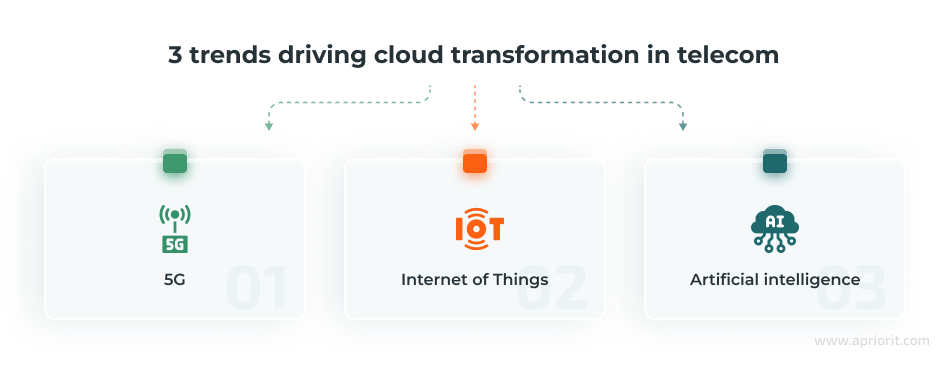
5G. Fifth-generation cellular networks are a must-have technology for every CSP, since 5G unlocks numerous possibilities for businesses, offering nearly 10 times faster data speeds than 4G. Many cloud vendors already tailor their services to telecom organizations’ needs with a view towards 5G implementation.
Internet of Things. Technologies like LTE-M and narrowband IoT (NB-IoT) protocols make it possible to connect IoT devices to a cellular network. Enhancing the cloud infrastructure with an IoT ecosystem is a promising investment idea, since mass consumption of IoT technologies is continuously accelerating. And with the growing number of SIM-based smart devices, the telecom industry expects to go beyond traditional telecommunications services and have lots of IoT business use cases in the near future.
Telecom organizations can leverage IoT for various purposes. For instance, some companies like Vodafone provide roaming capabilities, allowing users to connect to a cellular network in areas where the primary telecom has no infrastructure. AT&T leverages IoT capabilities to improve internal processes: for example, optimizing vehicle fleets and supply chain operations.
Artificial intelligence. AI is transforming how telecom companies operate and deliver services. Cloud-based AI/ML solutions are being used for network optimization (predictive maintenance, traffic management), enhanced customer experiences (personalized services, chatbots), and fraud detection. You might need AI to analyze the vast amounts of data generated by 5G networks and IoT devices, allowing your teams to automate complex tasks, improve efficiency, and create personalized services. Also, AI-powered analytics can also help predict network congestion, optimize resource allocation, and proactively address potential issues.
Although the merging of cloud computing and AI isn’t necessary, some use cases benefit from the concept of cloud-based artificial intelligence. For example, some cloud-based database servers keep the information required by AI always available, whether for access or use in decision-making and learning.
Benefits of cloud computing in telecom
Let’s break down some of the key benefits of cloud computing for telecom companies:
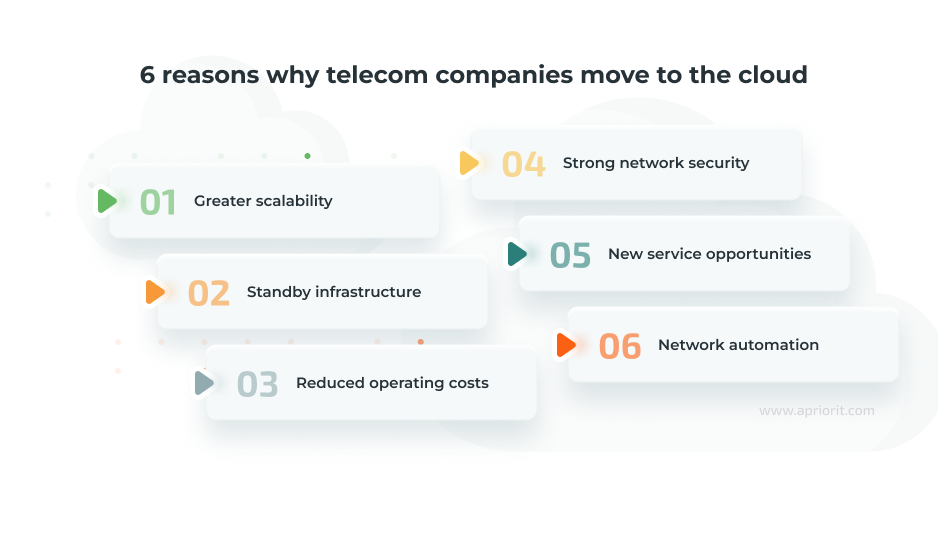
1. Greater scalability. Clouds allow telecom businesses to make their network infrastructure more agile and quickly adjust their services for seasonal spikes in demand, scaling up when demand rises and down when it falls.
2. Strong network security. Cloud adoption can help CSPs combine security best practices to make sure that all processes run efficiently and are protected. Such security measures include L4-L7 connections, VPNs, and web application firewalls.
3. Standby infrastructure. Data backups offered by cloud services help telecom companies keep services alive during accidents like power outages, as well as make systems resilient during extreme peaks in demand or in the event of system failure.
4. New service opportunities. With cloud computing services, CSPs can broaden their set of offered services and transform into digital service providers (DSPs). Being able to connect any user to any internet-connected device via messaging, video calls, and online conferences, telecom companies can significantly improve their customer experience compared to traditional telecommunications companies.
5. Reduced operating costs. Migrating to the cloud and reworking infrastructure require effort and funds. But by paying only for the cloud services they actually use, telecom organizations can significantly cut their operating costs in the long run. This pay-as-you-go model saves money that can be used for an organization’s development.
6. Network automation. With convenient cloud management systems, telecom companies can save lots of time and effort by automating various processes. For instance, they can leverage the CI/CD process to design and test new network components, deploy and orchestrate complex solutions, and monitor networks within the corporate infrastructure.
To better understand the impact of cloud computing on the telecom industry, let’s explore the key cloud-based technologies CPSs can adopt.
Read also
How to Optimize Network Performance: Proven Strategies from Apriorit
Learn how to optimize network performance with practical steps to boost speed, reduce latency, and handle high traffic demands. Our experts are ready to help you prepare your systems for growth!

Technologies powering cloud-based telecom infrastructure
Shifting towards cloud-based infrastructure is a complex process that requires businesses to carefully choose a deployment approach and technologies. There are four key technologies that telecom organizations can leverage when adopting cloud computing.
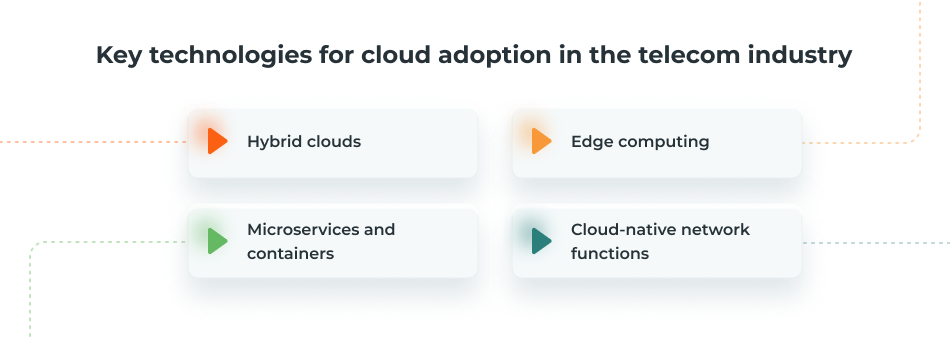
When it comes to the adoption method, telecom organizations prefer to go with a multi-cloud or hybrid cloud approach instead of choosing between private and public clouds. Telecom companies can run their most crucial applications in a private cloud, still leveraging vast sets of tools and services provided by public clouds. A combination of private and public clouds helps companies have more security and control their data in a cost-effective way. With hybrid clouds, data and applications are interoperable and horizontally portable.
Another technology that the telecommunication industry can benefit from when adopting clouds is edge computing. It helps CSPs store and process data in real time and accommodate a wider selection of devices. Cloud services based on edge computing bring lots of benefits like network performance improvements, low latency, high bandwidth, and data offload. For instance, companies like Verizon and SingTel have leveraged edge computing to launch commercial 5G mobile networks.
A beneficial architectural approach for cloud computing is using microservices and containers. The microservices architecture allows you to quickly develop, test, deploy, and manage new features without any impact on other network components. And containers significantly simplify the process of moving applications between environments without affecting network performance. Thus, telecom organizations can expand their services and networks efficiently and securely.
Last but not least, telecom organizations can greatly benefit from cloud-native network functions (CNFs). According to IDC, network functions virtualization infrastructure (NFVI) currently used by CSPs should be transformed into cloud-native network functions (CNFs). A CNF is a cloud native application that implements network functionality and consists of microservices. CNFs were developed to address limitations of Virtual Network Functions (VNFs) like slow upgrades, little elasticity, and poor scaling. With CNFs, telecom companies can be more flexible, scalable, and dynamic. Using containers, CNFs provide top-notch network functionality, which makes this technology a decent solution in the transition to 5G.
While cloud computing presents numerous opportunities, telecom companies also face significant challenges in their cloud adoption journey. In the next section, we discuss in detail which challenges of CSPs can be addressed using cloud computing in telecommunications — and how.
Major telecom challenges and how the cloud can help overcome them
The telecom industry faces several challenges as it works to keep up with growing customer demands, adopt new technologies, and stay competitive. In order to deliver reliable and scalable services, telecom companies need effective solutions, such as upgrading their infrastructure or improving service delivery. Let’s see what key challenges telecom companies face and how the cloud can help solve them.
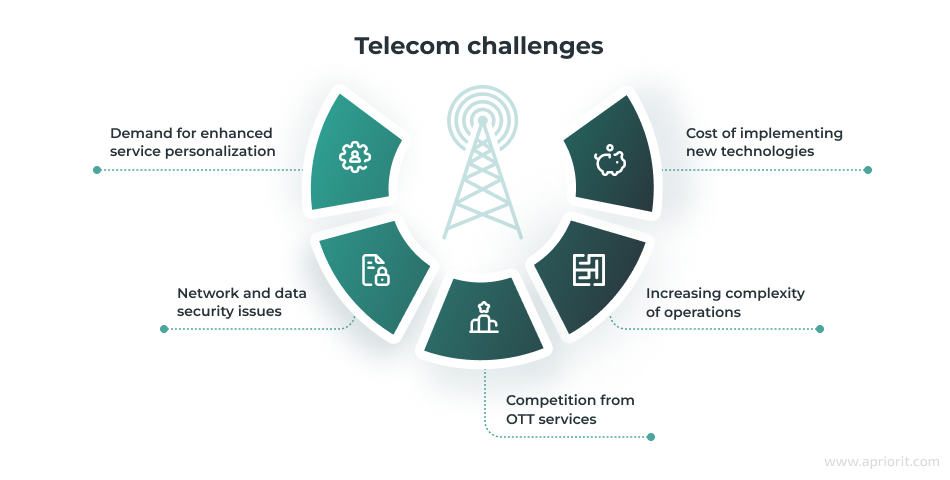
Demand for enhanced service personalization
Right now, telecom companies face competition with web scale cloud-based companies like WhatsApp, Skype, Telegram, and Facebook Messenger. Such apps became popular by providing fast and convenient communication channels for messaging as well as voice and video calls.
To maintain a competitive edge and open new growth opportunities, telecom operators have to meet high customization standards set by their cloud-based competitors. And to do that, the telecommunication industry should:
1. Focus on customer needs and provide top-notch services. To do this, telecoms can continuously improve the user experience for existing services as well as build additional products and services to engage their audiences.
2. Partner with large cloud providers instead of competing with them. Using the infrastructure of leading cloud providers, telecommunication organizations can offer high-quality services in various regions, including those located quite far away. Thus, telecom companies can leverage a cloud provider’s presence in or near the target region and offer their services with high-quality connections and budget-friendly regional traffic.
3. Leverage 5G technology to create new value-added services and enhance IoT services. 5G can be used not only to improve connectivity but to create new services. The global cloud gaming market was valued at approximately $2.8 billion in 2023 and is projected to grow at a compound annual growth rate of around 30% from 2024 to 2030.
Cost of implementing new technologies
Building 5G networks requires significant investment. While early estimates predicted extremely high costs per cell site, advances in technology and smarter deployment strategies are helping to lower expenses. Instead of focusing on fixed costs, it’s more useful to look at overall trends—costs are gradually decreasing as the technology matures and economies of scale take effect. However, 5G rollout still demands substantial capital from major carriers. And the software license fee for a 4G IoT system could cost up to $2.5 per device.
The three main things that bring additional costs are:

Using cloud computing can help telecom companies lower expenses for maintaining infrastructure and developing new services in the long run. For instance, with clouds, you can better plan for shorter upgrade cycles and meet customer demand for the latest technologies. Also, due to their nature, clouds provide scalability so that cellular infrastructure can expand its capacity and handle more traffic.
Combined with a microservices architecture, clouds allow telecom providers to develop, test, and deploy new services securely and conveniently. Thus, providers can deliver additional services and improve current ones to meet high consumer expectations without any impact on existing services.
Network and data security issues
With the adoption of new technologies, the security of networks and data becomes a top concern for telecommunications companies. Here are some of the most prevalent concerns in this area:
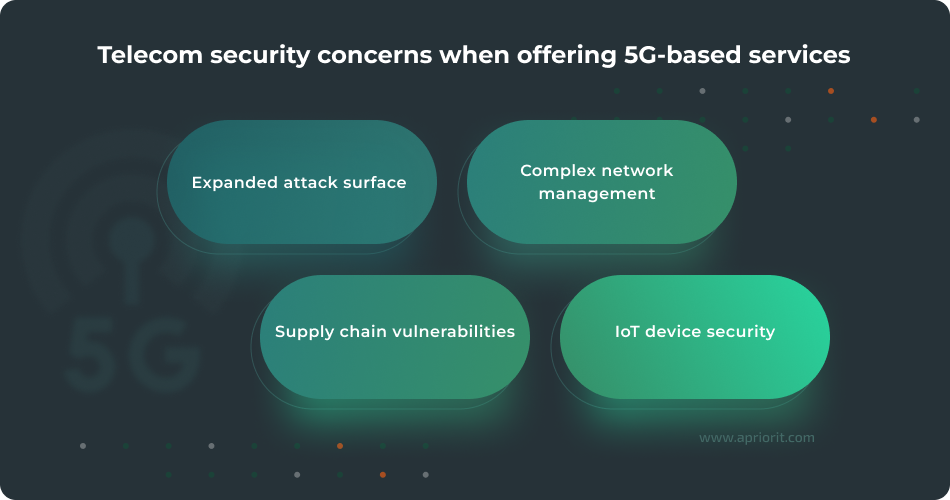
Expanded attack surface. The expansion of IoT devices and the extensive infrastructure required for 5G networks increase potential entry points for cyber threats. Each connected device, from smart home appliances to industrial sensors, can act as a gateway for malicious activities if not properly secured. As a result, hackers can exploit vulnerabilities in IoT devices to gain unauthorized access to networks, steal sensitive data, or disrupt operations. Common approaches to hacking include leveraging weak or default passwords, exploiting unpatched vulnerabilities in device firmware, or using unsecured communication protocols.
Complex network management. The flexibility and configurability of 5G networks allow telecom companies to deliver faster, more reliable, and customizable services. However, this flexibility introduces a layer of complexity that can result in configuration errors, mismanagement, and security loopholes. Misconfigurations, such as improper firewall settings or incorrect access permissions, can leave networks even more vulnerable to breaches.
Supply chain vulnerabilities. Telecom networks often rely on a diverse ecosystem of hardware, software, and services from multiple vendors. This dependency can introduce security risks, as even a single compromised vendor can jeopardize the entire supply chain. Attackers may insert backdoors, spyware, or other malicious code into software or hardware components during manufacturing or distribution. This type of supply chain attack can remain undetected for months, allowing attackers to steal data, disrupt operations, or sabotage systems.
IoT device security. Many IoT devices lack robust security features, often because of weak default passwords and insufficient update mechanisms. This makes them susceptible to botnet attacks, such as Mirai, which can be used to launch distributed denial-of-service (DDoS) attacks. Attackers also use brute force techniques to compromise devices with weak default credentials. Once compromised, these devices can be used to overwhelm network resources, steal sensitive data, or even manipulate industrial systems.
To address such security challenges, telecom companies can leverage clouds for network security, again treating cloud vendors not only as their competitors but also as their partners. Out-of-the-box solutions from cloud providers already offer various mechanisms for infrastructure security. AWS, for example, offers security groups and identity and access management roles as part of its cloud security offering.
Note that different providers (of both private and public clouds) can use different terms for similar or even the same functionalities and offer different sets of features. CSPs should keep such nuances in mind, especially when working with hybrid clouds.
It’s also worth saying that security is a shared responsibility, so telecom companies should carefully examine cybersecurity opportunities of different cloud providers and think of additional security measures if needed.
Read also
Establishing Network Observability: Benefits, Use Cases, Practical Tips
Don’t let network downtime disrupt your operations! Learn how network observability tools and strategies provide critical insights into performance bottlenecks, helping you resolve problems before they impact your systems.

Increasing complexity of operations
Since the number of telecom consumers and the number of services offered by telecom companies keep rising, internal processes become more complex. Handling customer service along with service configuration, invoicing, payments, and other operations requires resources and efficient tools. And such tools have to work not only efficiently but also fast, because consumers won’t tolerate any delays in processes.
Using cloud computing to overcome this challenge will help telecom businesses significantly improve operations management. For instance, Ericsson has already partnered with AWS to bring their business support systems to the cloud. Automatic scaling and managed cloud services can help telecom organizations react faster to customer demands and simplify activities for operations and development teams.
Competition from OTT services
Over-the-top (OTT) services like Netflix, YouTube, WhatsApp, and Skype have disrupted the telecom industry by bypassing traditional communication and content delivery channels. Since these platforms deliver voice, video, and messaging services directly to consumers over the internet, they offer compelling alternatives to traditional voice, messaging, and entertainment services provided by telecom companies. This competition presents several challenges, including:
- Growing customer expectations in terms of the user experience, including demand for seamless performance and innovative features
- Declining revenue from traditional services such as voice calls and SMS
- Increased pressure on pricing in order to remain competitive
- Difficulties in differentiating products from the innovative and feature-rich services provided by OTT players
Cloud computing can help telecom companies compete with OTT services and address these challenges by:
1. Collaborating with OTT providers. As a result of this collaboration, telecom operators can offer bundled services, such as internet plans that include subscriptions to platforms like Netflix or Spotify. This approach can both retain customers and generate new revenue streams. For example, AT&T acquired Time Warner (now WarnerMedia) to offer exclusive content through its streaming service HBO Max, giving AT&T a competitive edge in the OTT-dominated market.
2. Monetize network use. The network traffic generated by OTT services can also bring new revenue streams for telecom companies. For example, they can negotiate revenue-sharing agreements with OTT providers or charge premium rates for bandwidth-intensive applications.
3. Adopt network slicing to differentiate services. With the help of this approach, telecom companies can offer ultra-low latency and high bandwidth for seamless cloud experiences. This is especially relevant for gaming, telemedicine, and IoT applications. For example, telecom companies can collaborate with industrial partners to develop private 5G networks for critical infrastructure, such as smart factories and smart grids.
Next, let’s explore the key challenges telecom organizations face when implementing and managing cloud solutions and how they can overcome them.
Challenges of implementing and managing clouds
Although cloud adoption is an ongoing trend for CSPs that brings various benefits, implementing and managing cloud-based telecommunications services and systems is tricky. Let’s explore some of the pitfalls to expect when adopting cloud infrastructure.
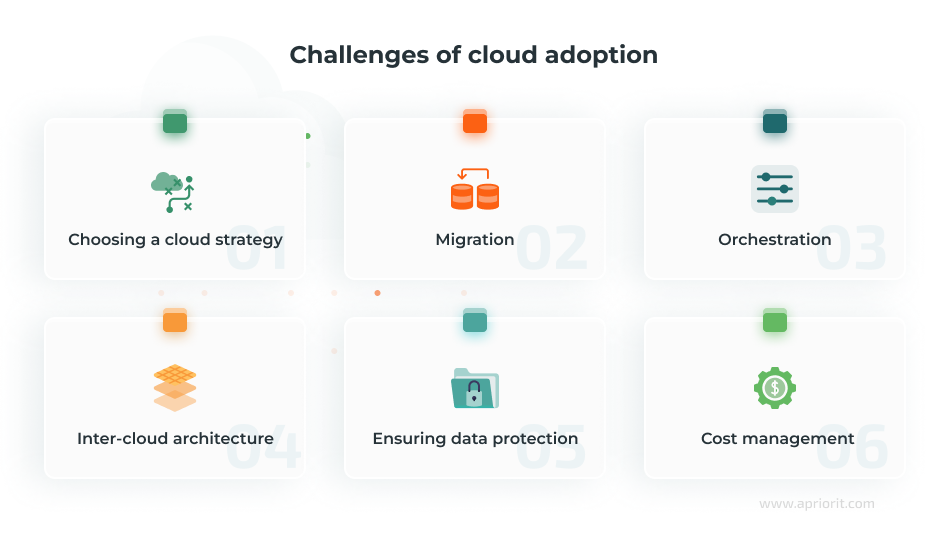
Choosing a cloud strategy. Complex infrastructures like those in telecom organizations usually require hybrid clouds or multi-clouds. Both options aim to minimize dependence on a single provider, often cutting costs and improving flexibility. The hybrid scheme always includes the use of private and public clouds, with all components of a hybrid cloud typically working together. Multi-clouds, on the contrary, use multiple public cloud services. Although multi-clouds are used for different tasks, they usually operate in combination with on-premises physical, virtual, and private cloud infrastructure.
You should also carefully choose your cloud providers. Some clouds can be better than others, depending on your organization’s goals. They can provide different capabilities and terms for computing specifics, storage, and prices. Sometimes, differences lie in unobvious but important details. For instance, you expect Kubernetes to be managed in the same manner across all clouds. However, not all cloud providers manage Kubernetes in the same way.
Migration. Moving to a new cloud infrastructure can be time-consuming and require lots of effort. You have to consider numerous details like specific cloud providers, as well as features and components they provide: databases, native monitoring systems, and various tools.
Here’s a short list of the crucial things you should analyze before starting migration:
- Operational requirements and performance characteristics
- Container and microservices platforms for application development
- Capacity planning and elimination of unused services
- Provisioning of data, storage, network, and security
- Financial details like metering, reporting, and charges
Orchestration. True elasticity within cloud environments requires the orchestration of multiple components within the data center. And service orchestration is tricky, since the lifecycle of distributed services is typically more complex compared to individual containers.
The major challenges related to cloud orchestration are:
- Complex lifecycle management
- Resource allocation and use
- Handling multiple tenants, each with their own requirements and all isolated with security controls
- Choosing the most suitable cloud orchestration software
Inter-cloud architecture. Whether you choose to design a private cloud with the intention of transitioning to a hybrid architecture or you want to build a multi-cloud infrastructure, the process can be complicated and time-consuming.
With hybrid architectures, you might need to make significant changes to the data center architecture to meet specific inter-cloud needs and requirements. These could be:
- Secure interconnectivity between private and public cloud environments
- Automatic migration of in-house applications to the cloud
- Replicating specific infrastructure components in the public cloud part of a hybrid model
- Support for new technologies that will be added later
Cost management. Over time, it becomes harder to understand and manage cloud pricing. The reason is that charges differ depending on computing, storage, networking, memory type, region or zone, number of requests, and other factors. Some providers charge not only for the size of the load balancer instance but also for the type of instance and the number of requests an instance will handle per server per second.
To manage and forecast expenses for cloud services, it’s best to use cost management and projection tools offered by your provider.
Ensuring data protection. Security is a shared responsibility. Even though providers of public cloud services have data protection measures in place, organizations should put efforts into data security. In enterprise environments, the most critical data is mostly secured when stored in a private cloud, whether it’s in a physical on-premises cloud, co-located servers, or a VPN.
When data moves to and from public clouds, it can lead to different security challenges. For instance, data can be vulnerable to DDoS and MitM attacks. To protect data, you should incorporate software encryption and hardware security modules into your cloud architecture.
Other risks can be posed by employees’ devices when they access sensitive data from the private cloud or on-premises data centers. Since employee devices can be connected to other networks beyond the organization and are not fully secured, it’s vital to identify threats at all access points connected to such devices and enforce tough security protocols to prevent data leaks.
Despite the mentioned challenges, clouds have the potential to significantly transform CSP infrastructures in a beneficial way. You shouldn’t consider cloud computing as only a set of virtual servers and a network that connects them. Leveraging cloud providers’ offerings, telecom companies can dramatically change their approach to accomplishing routine tasks and delivering new products.
One of the most popular examples of using clouds to optimize resources, increase agility, and respond to customer demands is the Jazz Serverless Development Platform. This platform was created by wireless network operator T-Mobile using AWS serverless technologies. Now, Jazz allows developers to build secure and efficient services, saving significant amounts of time thanks to automated operations and other benefits of serverless computing.
Implementing and managing cloud computing in the telecom industry is a complex process that requires deep expertise and careful planning. You might need an experienced partner to navigate these challenges and help you achieve maximum efficiency.
Related project
Streamlining Electric Vehicle Charging Support with an AI Chatbot
Explore how our team integrated an AI chatbot to provide instant, intelligent support for EV drivers, improving the customer experience and optimizing service efficiency.

How can Apriorit help with cloud computing adoption?
Adopting cloud computing in the telecom industry involves more than simply migrating services to the cloud — it requires seamless integration of cloud development and infrastructure management to create scalable, secure, and efficient solutions. At Apriorit, we have extensive experience helping businesses adopt cloud technologies and optimize their infrastructure to maximize efficiency and scalability. Here is how we can support your transition:
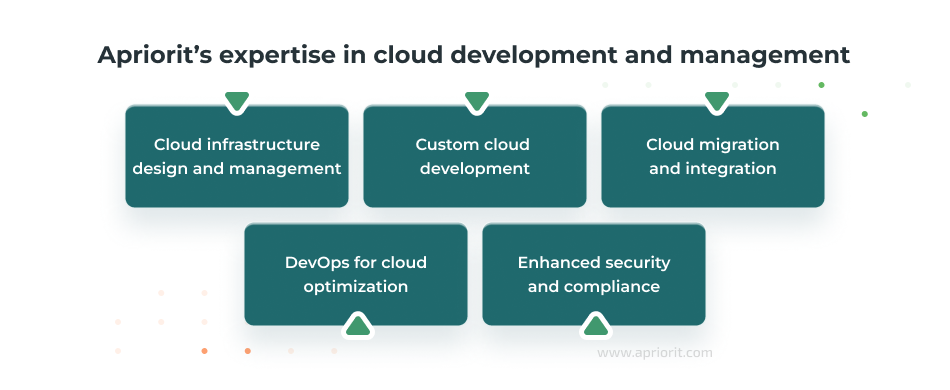
- Cloud infrastructure design and management. Optimize resource use and minimize costs with scalable cloud infrastructure tailored to your needs.
- Custom cloud development. Develop and deploy custom cloud-native applications using microservices, containers, serverless functions, and other technologies.
- Cloud migration and integration. Seamlessly migrate your existing applications and data to the cloud with minimal downtime and business disruption.
- DevOps for cloud optimization. Implement DevOps best practices and CI/CD pipelines to accelerate software delivery, improve quality, and boost operational efficiency in your cloud environment.
- Enhanced security and compliance. Security is always our top priority. We protect your data and ensure regulatory compliance with data encryption, access controls, and threat detection.
At Apriorit, we have extensive experience helping businesses adopt cloud technologies and optimize their infrastructure to maximize efficiency and scalability, which makes us a perfect partner for you!
Conclusion
Cloud computing is no longer optional for telecom companies; it’s essential for staying competitive and thriving. As they embrace cloud technology in the telecom industry, CSPs can modernize their infrastructure, boost the variety of services, and unlock new avenues for growth.
However, successfully overcoming the challenges of cloud adoption requires careful planning and execution. From selecting the right cloud strategy and vendors to managing security and ensuring seamless integration, you should partner with an experienced team for your cloud transformation. At Apriorit, we specialize in helping telecom companies leverage the power of cloud computing and cloud infrastructure.
Looking for cloud development and management experts?
Let us streamline your IT operations with cutting-edge virtualization and cloud computing solutions tailored to your business needs.



